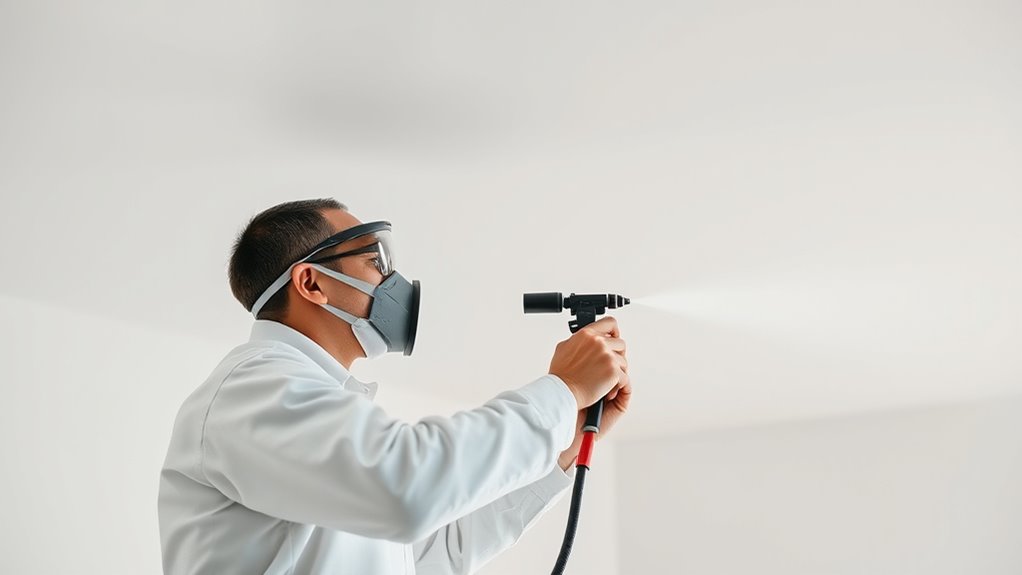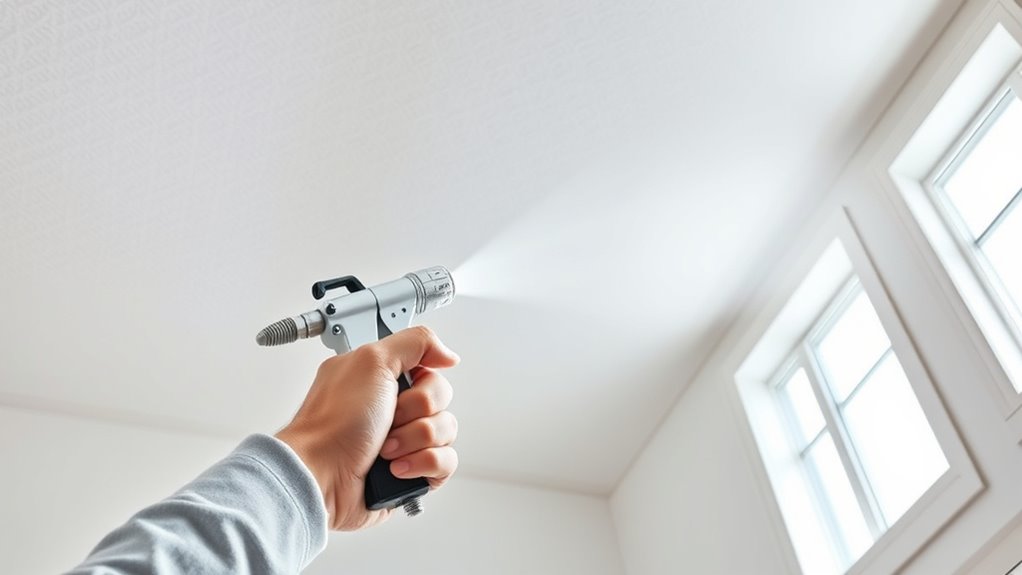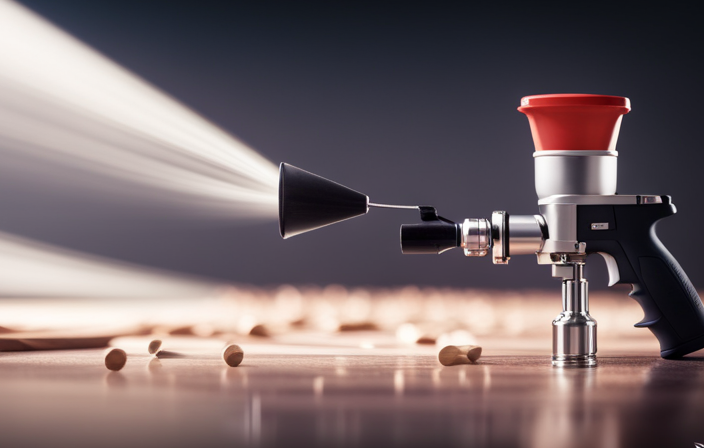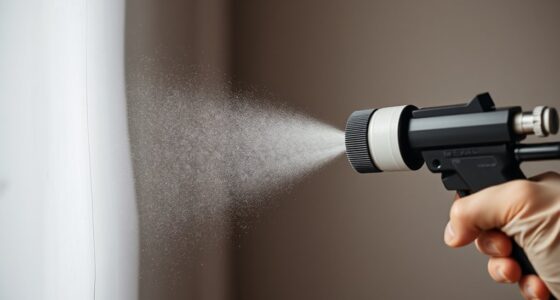To spray ceilings without a mess, start by fully covering floors and furniture with drop cloths or plastic sheeting, taping off edges and fixtures. Properly set up your sprayer with clean filters and practiced technique, maintaining a consistent distance and overlapping passes. Work in a well-ventilated space, controlling overspray with plastic barriers. After finishing, disassemble and rinse your equipment thoroughly. Master these pro moves, and you’ll achieve a clean, smooth ceiling—learn more tips to perfect your technique.
Key Takeaways
- Prepare the room thoroughly by covering floors and furniture with plastic sheeting and taping off edges to contain overspray.
- Use painter’s tape around walls, vents, and fixtures to protect surfaces and ensure clean lines.
- Maintain a consistent spraying distance and overlapping passes for even coverage and minimal splatter.
- Work in a well-ventilated space with cross-breezes, and control airflow to prevent dust and overspray dispersal.
- Clean and disassemble the sprayer immediately after use to prevent clogs and ensure a tidy, professional finish.

Spraying ceilings can quickly become a messy ordeal, but with the right techniques, you can keep your space clean and paint efficiently. The key is preparation. Before you even pick up the sprayer, clear the room of furniture or cover everything with drop cloths. Use painter’s plastic or thick tarps to shield floors and belongings from overspray. Taping edges around walls, vents, and light fixtures with painter’s tape creates a barrier that minimizes drips and splatters. Taking these steps upfront saves you time and effort later on cleaning.
Next, focus on your equipment. Make sure your sprayer is in good working order—clean filters, proper nozzle size, and correctly mixed paint. Thinning the paint slightly, if recommended by the manufacturer, ensures a smoother spray pattern and reduces the chance of drips. Practice on a scrap piece of drywall or cardboard to get a feel for the spray pattern and pressure. This helps you achieve even coverage and prevents over-spraying in one area.
Ensure your sprayer is well-maintained with clean filters and the right nozzle for smooth, even ceiling coverage.
When you start spraying, maintain a consistent distance from the ceiling—usually about 10 to 12 inches—and keep the sprayer moving in steady, overlapping passes. Moving too slowly can cause runs or drips, while rushing can lead to uneven coverage. Use a controlled, sweeping motion and avoid pausing in one spot, which might cause pooling. If you notice drips forming, reduce your pressure or slow your movement. Keep an eye on your spray pattern and adjust as needed to maintain an even coat.
To prevent overspray from drifting onto unintended surfaces, work in a well-ventilated space with cross-breezes. If possible, close off vents and doors to contain the spray area. Consider taping down plastic sheeting over adjacent walls or fixtures you can’t move. Wearing protective gear—like goggles, a mask, and clothing that covers your skin—also helps keep overspray off your body and clothes. Additionally, understanding your equipment and its capabilities can prevent common issues that lead to messes or uneven coverage.
Finally, clean your equipment immediately after finishing. Disassemble the sprayer and rinse all parts according to the manufacturer’s instructions. Proper cleaning prevents clogs and ensures your sprayer stays in top condition for future projects. With these techniques, you’ll spray ceilings efficiently while keeping your space clean, saving you time on cleanup and giving you professional-looking results.
Frequently Asked Questions
What Types of Ceiling Paints Are Best for Spraying?
You should choose high-quality, low-VOC latex or acrylic paints designed for spraying. These paints flow smoothly, reduce overspray, and provide even coverage, making your job easier. Opt for paints with a thinner consistency for better atomization and minimal drips. Always shake or stir thoroughly before spraying, and consider using a primer for better adhesion and a more uniform finish. This combo helps you achieve professional results without a mess.
How Do I Prevent Overspray on Walls and Floors?
To prevent overspray on walls and floors, you should mask off edges with painter’s tape and plastic sheeting. Wear a spray shield or cardboard to block spray from hitting unwanted surfaces. Keep a steady hand and maintain consistent distance from the ceiling. Work in small sections, and frequently check for drips or overspray. Proper prep and controlled spraying techniques guarantee a clean, professional finish without messes.
What Safety Gear Is Recommended for Ceiling Spraying?
You should wear safety goggles and a mask to protect your eyes and lungs from overspray and fumes. Gloves keep your hands clean and safe from chemicals, while coveralls or old clothes prevent paint from staining your skin and fabric. Ear protection is also wise if you’re using loud spray equipment. These safety measures keep you protected while you work efficiently, ensuring a safer, cleaner ceiling spraying experience.
Can I Spray Textured or Popcorn Ceilings?
Yes, you can spray textured or popcorn ceilings, but you need to be careful. Use a spray gun designed for textured finishes and keep the spray at a consistent distance. Test on a small area first to confirm adhesion and appearance. Remember to wear protective gear like goggles, a mask, and coveralls to avoid inhaling dust or getting paint on your skin. Proper preparation makes the job cleaner and more effective.
How Long Should I Wait Before Cleaning up After Spraying?
You should wait at least 24 hours before cleaning up after spraying your ceiling. This allows the spray to dry and set properly, preventing smudges or damage. If you’re in a hurry, check the manufacturer’s instructions for specific drying times. During this period, keep the area well-ventilated and avoid touching the surface to ensure a smooth, clean finish. Patience now safeguards you from messes later.
Conclusion
So, next time you tackle ceiling spraying, remember these pro tips. With a steady hand and smart techniques, you’ll transform a messy task into a smooth, almost dance-like motion. Think of it as painting a clear sky—precise, calm, and mess-free. When you master these moves, your ceiling becomes a canvas, not a disaster zone. Trust yourself, stay focused, and watch your work soar above the chaos like a bird in perfect flight.










